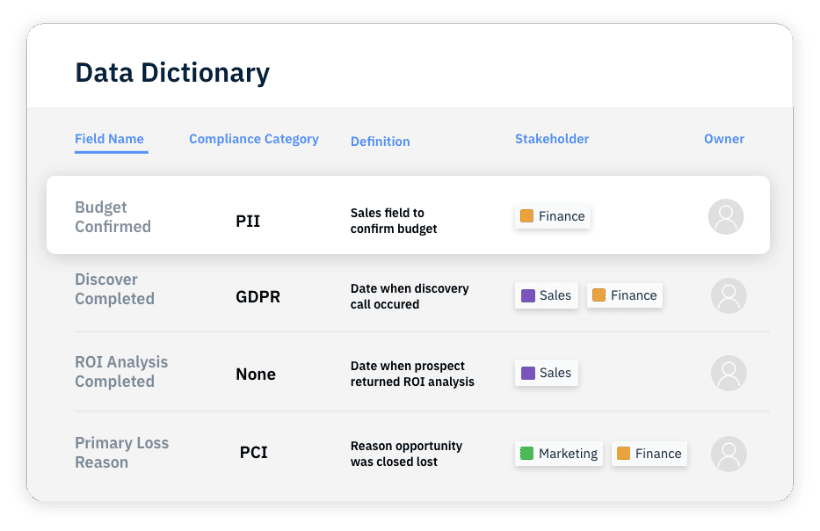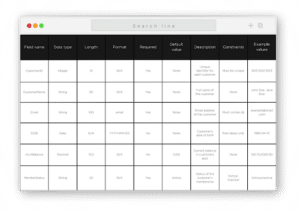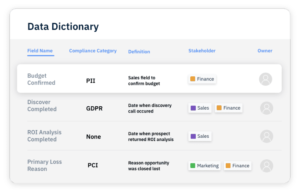A data dictionary is a collection of the names, attributes, and descriptions of the data objects or business logic of a data model to ensure all business users or stakeholders are consistent in how they refer to these items. Often a data dictionary is a centralized metadata repository.

What is the importance of a Data Dictionary?
The numbers don’t lie… when it comes to keeping your CRM updated and compliant, a data dictionary helps check all the boxes. Research shows:
Avg. time data teams spend on data cleaning, integration and preparation
Of data teams have started building automation into their data management process
Avg. time data teams spend on data cleaning, integration and preparation
Of teams struggle to maintain a database of trusted data for analytics
Well kept data dictionaries are valuable as they foster improved data integrity, reduce the risk of data leakage and ensure consistency in data use. As an outcome, businesses are able to become more agile in their decision making based on reliable data.
How do you create a Data Dictionary?
When developing a data dictionary for your Salesforce org, it’s important to start with a plan in mind. There are 8 steps to follow when thinking about how to document your metadata:
- Define the scope: Determine what aspects of your Salesforce org need to be included in the data dictionary. This might include standard and custom objects, fields, relationships, validation rules, workflows, processes, etc.
- Gather information: Use Salesforce’s built-in tools like Schema Builder, Object Manager, and Setup Menu to gather information about the objects and fields in your org.
- Use reports and data export: Utilize Salesforce reports or data export options to extract metadata about your objects and fields. This can be a starting point for your data dictionary.
- Document standard objects and fields: Begin by documenting the standard objects and fields provided by Salesforce. Include field labels, API names, data types, lengths, default values, descriptions, etc.
- Document custom objects and fields: Similarly, document all custom objects and fields created in your Salesforce org, ensuring to capture the same level of detail as for standard elements.
- Include relationships: Document how objects are related, such as master-detail and lookup relationships. This helps in understanding data models and dependencies.
- Describe business rules and validation: Include any business rules, validation rules, or formulas associated with fields and objects. This provides context on how data integrity is maintained.
- Record page layouts and record types: Document which fields are used in different page layouts and record types, as this affects how users interact with the data.
- Add user permissions and field-level security: Document who can view and edit each field. This is vital for understanding and maintaining data security and compliance.
- Maintain and update regularly: A Salesforce data dictionary is not a one-time task. Regularly update it to reflect any changes in your Salesforce org.
- Choose a format: Decide whether to use a spreadsheet, a specialized documentation tool, or a custom solution built in Salesforce to maintain your data dictionary.
- Ensure accessibility: Make sure the data dictionary is easily accessible to those who need it, such as admins, developers, and business analysts.
- Review and validate: Have key stakeholders review the data dictionary to ensure accuracy and completeness.
- Educate your team: Ensure that your team knows about the data dictionary and understands how to use it.
Remember, the goal of a Salesforce data dictionary is to provide a clear, comprehensive, and up-to-date reference for all the data elements within your Salesforce environment, which is crucial for effective management, development, and use of the platform.
What is the function of a Data Dictionary?
Data dictionaries are used to ensure consistency in process and execution, build accurate and complete reporting, ensure data quality and understand data sensitivity. A robust and up-to-date data dictionary should provide a variety of benefits including:
Standardized terminology:
Ensures all GTM counterparts use the same terminology and understands fields and usage in the same way.
Documentation of fields:
Documents all Salesforce fields, including standard fields provided by Salesforce and custom fields created by the organization. This documentation typically includes the field’s name, type, description, constraints, and any other relevant metadata.
Facilitates data quality:
By providing clear definitions and constraints for each data element, a Salesforce data dictionary helps to maintain data quality. It makes it easier for users to enter data consistently and accurately.
Aids in training and onboarding:
New admins or employees can refer to the data dictionary to better understand the Salesforce data model, which can significantly speed up their onboarding process and avoid new admins from breaking processes and workflows.
Supports reporting and analysis:
A clear understanding of what each data field represents is crucial for accurate reporting and analysis. The data dictionary serves as a reference point to ensure that reports are built on a correct understanding of the data.
Enhances data governance:
It supports data governance initiatives by providing a clear framework for how data is structured, used, and managed within Salesforce.
Assists in system integration and development:
For developers and system integrators, the data dictionary provides vital information needed to integrate Salesforce with other systems or to develop custom applications within the Salesforce platform.
What elements does a Data Dictionary contain?
A Salesforce Data Dictionary contains detailed information about the data elements used within the Org. Here are some key elements defined within a Salesforce Data Dictionary:
- Field Label and API Name: The user-friendly label and the unique API name used by developers for each field.
- Data type: Specifies the type of data (e.g., text, number, date, picklist, lookup relationship).
- Length: For text fields, the maximum number of characters allowed.
- Precision and scale: For numeric fields, precision represents the total number of digits that can be stored, and scale represents the number of digits to the right of the decimal point.
- Required/optional: Indicates whether a field is mandatory or optional.
- Default value: The predefined value a field will have upon record creation, if no other value is specified.
- Formula: If the field is a formula field, the formula used to calculate its value.
- Picklist values: For picklist fields, a list of all possible values.
- Description and help text: A description of the field’s purpose and any help text provided for users.
- Unique identifier: Whether the field is marked as unique (e.g., for external IDs).
- Relationships: Details of relationships with other objects (e.g., master-detail or lookup relationships).
- Validation rules: Any validation rules applied to the field.
- Field-level security: Information on which profiles or permission sets have access to the field.
- Record types: The record types with which the field is associated.
- Page layouts: Information on which page layouts the field appears.
- Usage notes: Any additional notes on how the field is used within the organization, like in workflows, processes, or integrations.
- History tracking: Indicates if changes to the field are tracked in the object’s history.
What does a Data Dictionary look like?
There are traditional Salesforce data dictionaries and then there are modern, automated data dictionaries. Let’s compare the two side by side.
Traditionally, a data dictionary is managed within an Excel or Google sheet that systematically lists and describes all the data elements in a particular system, database, or application. The format can vary, but it generally includes several standard columns for each data element. Here’s a simplified example of what a basic data dictionary might look like:

It will list the structure and definition of a variety of data including:
- Field Name: The name of the data element or field.
- Data Type: The type of data stored in the field (e.g., Integer, String, Date, Decimal).
- Length: The maximum size of the data field (important for strings).
- Format: Any specific formatting rules (like date or number formats).
- Required: Whether the field is mandatory or optional.
- Default Value: The default value for the field, if not specified.
- Description: A clear description of the field and its purpose or use.
- Constraints: Any restrictions or rules applied to the field.
- Example Values: Sample data that could be stored in the field.
This is a basic format, and real-world data dictionaries can be more complex, including additional information like relationships to other data elements, usage notes, source information, versioning, and more. The exact structure and complexity of a data dictionary will vary based on the needs of the organization and the system it describes.
The challenge with traditional data dictionaries:
While implementing a Salesforce data dictionary is a must for most admins and Ops teams, maintaining a manual spreadsheet is a massive undertaking. Especially when there are multiple hands responsible for executing Salesforce metadata changes.

With so many challenges being expressed among the community surrounding their current metadata documentation processes, Sonar decided to provide a solution with our new automated Data Dictionary feature.
Sonar’s dynamic data dictionary isn’t only accurate but automated – finally freeing up time for your team to focus on more strategic initiatives. Additional benefits include:
- Saved time: Enable your team to spend less time documenting changes and more time focusing on what you hired them to do – creating efficiencies that optimize budget and drive revenue.
- Mitigated risk: Safeguard intellectual property and ramp new hires faster with Sonar. Automatically capture and document complete Salesforce metadata and apply context that’s always accurate and can be accessed by stakeholders across your enterprise.
- Guaranteed consistency: Make sure everyone in your organization is speaking the same language when it comes to your CRM data. Sonar’s data dictionary creates transparency into definitions and improves organization literacy regarding your objects, fields, flows and more.
Who uses a Data Dictionary?
A Salesforce data dictionary is used by various stakeholders within an organization who interact with the Salesforce CRM system. Each group uses the data dictionary for different purposes:
- Salesforce admins
- Developers
- Data analysts and BI teams
- Business users and managers
- Data governance teams
They use the data dictionary to manage and configure the Salesforce environment. It helps them understand the structure and relationships of data within the system, which is crucial for tasks like creating new fields, modifying layouts, setting up workflows, and managing user access.
For those who develop custom applications or integrations in Salesforce, the data dictionary provides essential information about data structures, field types, and relationships. This knowledge is vital for writing efficient and effective Apex code, designing Visualforce pages, and developing Lightning components.
Analysts use the data dictionary to understand the data available for reporting and analytics. It helps them ensure that they are using the correct fields and understand the data’s nuances, leading to more accurate and meaningful reports and insights.
While they might not interact with the data dictionary as frequently, it can still be a valuable resource for understanding the data they work with in Salesforce, especially when creating reports, dashboards, or analyzing data for decision-making.
These teams use the data dictionary to enforce data standards and policies across the organization. It’s a key tool in maintaining data quality, consistency, and security within Salesforce.
Who creates a Data Dictionary and manages it?
The creation and management of a Salesforce data dictionary is typically a collaborative effort, involving several roles within an organization:
Salesforce administrators
They often take the lead in creating and updating the data dictionary. Administrators have the necessary access and understanding of the Salesforce environment to document fields, objects, relationships, and other configurations.
Salesforce developers
In organizations with custom Salesforce development, developers may contribute to the data dictionary, especially for custom objects and fields, Apex classes, and triggers. They provide technical details that are essential for understanding how customizations fit into the overall data model.
Business analysts
These professionals often assist in defining and documenting business rules, field descriptions, and usage guidelines. They ensure that the data dictionary aligns with the business context and requirements.
Data governance team
If an organization has a data governance team, they might oversee the data dictionary to ensure it adheres to data standards and policies. They play a crucial role in maintaining data quality and consistency.
Project managers or CRM managers
In some cases, a project manager or a CRM manager might oversee the creation and maintenance of the data dictionary, coordinating between different stakeholders and ensuring the document stays updated.
End users or subject matter experts (SMEs)
Input from end users or SMEs can be crucial in ensuring that the data dictionary is accurate and reflects the real-world use of the Salesforce system.
The management of the data dictionary is an ongoing process. It requires regular updates to reflect any changes in the Salesforce environment, such as the addition of new fields, changes to business processes, or implementation of new modules. Regular audits and reviews are essential to ensure that the data dictionary remains an accurate and reliable resource.
When should I create a Data Dictionary?
It may be clear by now why you need a Salesforce dictionary. But how do you know when it’s the right time to start investing in one? There’s five key signs it’s time your organization should implement an automated Salesforce data dictionary:
- Misalignment among GTM teams: If Go-To-Market (GTM) teams are not consistent in their understanding and use of Salesforce data, issues like data silos, technical debt, and inaccurate reporting arise. A data dictionary helps align these teams by providing clear metadata definitions, reducing tech debt, and aiding faster, informed decision-making.
- Need for data governance for regulatory compliance: Companies focusing on data governance may have already invested in Salesforce Shield as a first step to to avoid non-compliance fines or data breaches. But you can also take it a step further with a data dictionary. It streamlines the process of establishing common data definitions and formats across business systems.
- High turnover in operational teams: Frequent changes in Salesforce administrators create a learning curve and potential operational disruptions. A data dictionary helps new team members quickly understand the existing Salesforce setup, reducing onboarding time and errors.
- Deploying a new Salesforce instance: Starting with a well-documented data dictionary during the implementation of Salesforce ensures that every metadata element is recorded, providing context and continuity beyond the tenure of initial administrators.
- During mergers and acquisitions: In M&A situations, understanding customer overlap and CRM data is crucial for customer retention, process optimization, and staff transition. A data dictionary offers valuable insights into Salesforce fields and flows, aiding in these transitions.
How does a Data Dictionary strengthen your compliance and governance strategy?
A typical enterprise data governance program involves creating standardized definitions of data and uniform data formats. These standards are implemented across various business systems, enhancing the uniformity and reliability of data for both business operations and compliance purposes. Having a Salesforce data dictionary can strengthen the foundation of your data architecture by providing:
A common data standard
Data governance can help achieve this by defining data rules definitions for each element, so they are consistent and data integrity is enforced.
Data interoperability
As the data begins to flow across connected systems and stakeholders, a governance process is essential to keeping the data ownership and structure in place.
Data access and usage
As access to data increases and the volume of data requests grows, data governance can help ensure that data is used and shared appropriately.
Data security and privacy
A formal data governance framework enhances data security and privacy and helps agencies meet their compliance obligations.
Simplify metadata documentation with Salesforce Data Dictionary
Maintaining an up-to-date data dictionary for Salesforce doesn’t have to be so difficult. Sonar’s dynamic data dictionary automatically captures changes across your Salesforce org and can instantly generate definitions, descriptions and hep text to your Salesforce metadata. Mitigate risk and improve the agility of the team supporting effective change management for your business.
